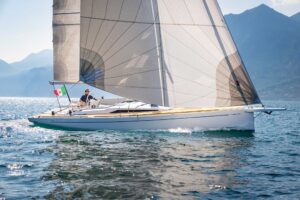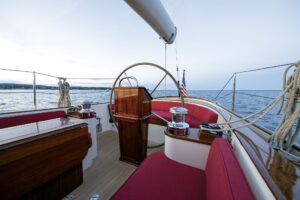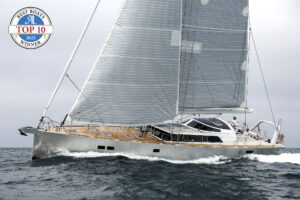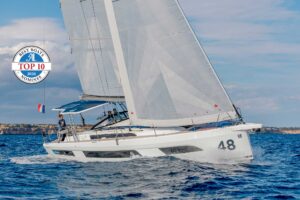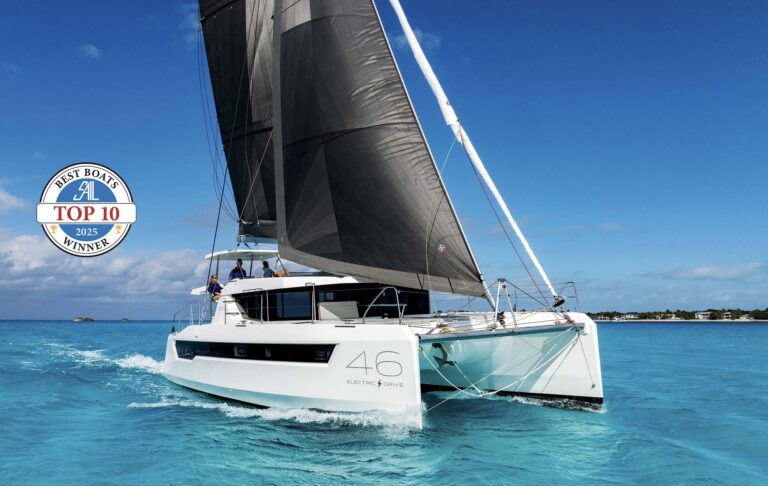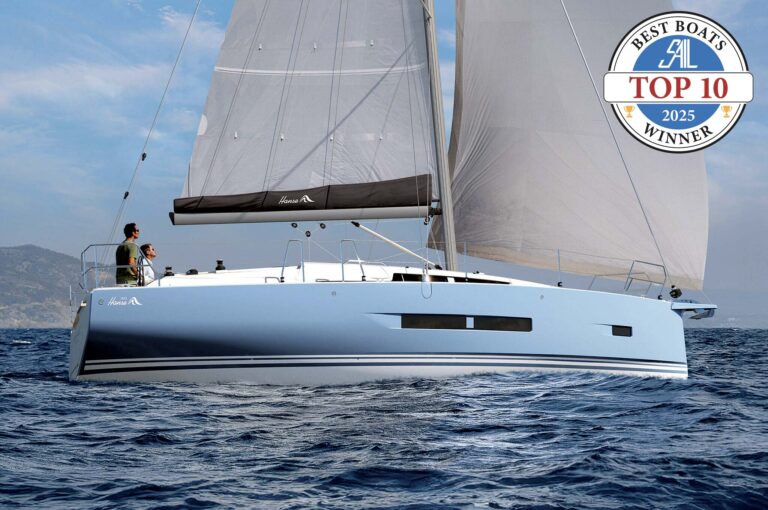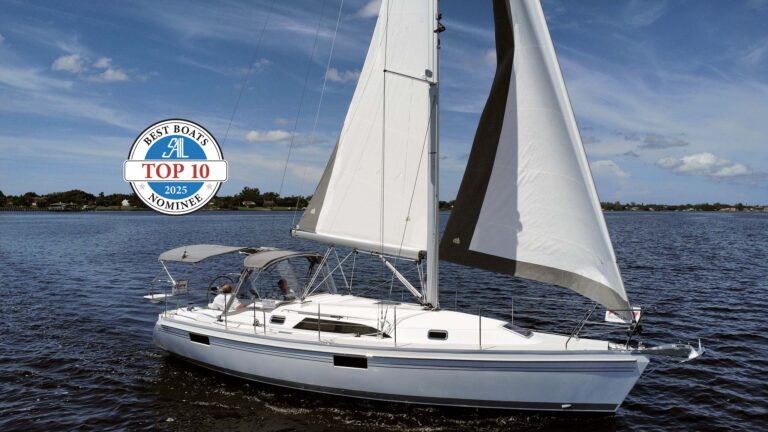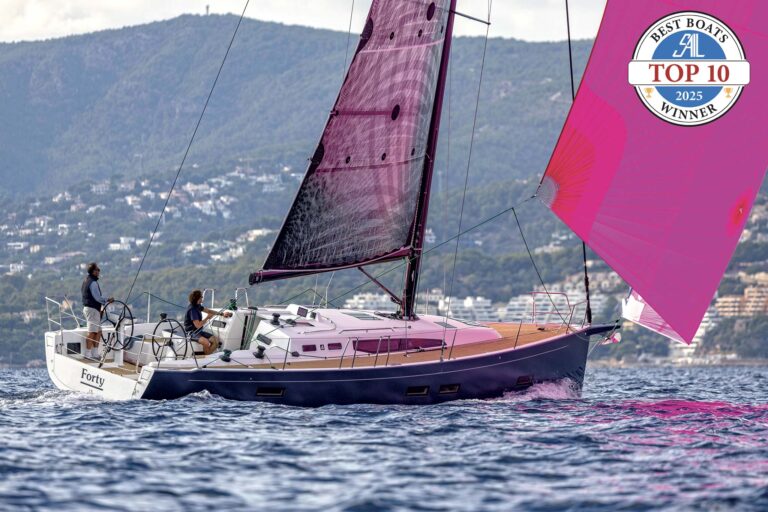
Carbon-based life evolves, silicon-based computers evolve, and so do fiberglass yachts. Oyster Marine understands this principle well and through steady improvements and innovations has established new standards for all its designs and systems without sacrificing the essential qualities that have been successful in earlier models.
The Oyster 53 is a prime example. Since its introduction in 1999, over 40 of these Rob Humphreys–designed yachts have been built. But as with all Oysters, there has been an ongoing discussion between the design and build teams on how to improve the breed. The latest iteration, which Oyster is calling the “fifth-generation deck,” or G5 for short, modernizes the boat while keeping its essence intact. Humphreys’s hull shape has not been changed, and the original deck design is still available if you want it. But there’s a good bit to recommend the G5. It minimizes the lines of the deck saloon (another Oyster innovation) and gives the boat a very different appearance, increasing freeboard slightly and adding overhead space in the galley, the owner’s cabin, and the aft head compartment.
Ironically, the softer flow of the new deck contour and the all-black framing around the windows gives the yacht a more aggressive look. The 53 doesn’t have the flash of an Aston Martin, but the look is far from stodgy.
The Oyster design team had introduced two models with a new raised-saloon profile before taking another look at the deck contour of the 53. “We introduced a new 46-footer and a 72-footer two years ago in London, and at the time we weren’t planning any dramatic changes in the existing range,” says Oyster USA’s Robin Campbell. “But the reception the new boats received, particularly from our current owners, convinced us to take another look at some of our existing designs, particularly in terms of improvements to deck layouts and the structures above the deck.”
Deck shape is one thing; making major alterations to the rig is quite another. On the older Oyster 53 configurations, the mainsheetand in-mast furling lines ran across the top of the deck. That’s been changed on this new model, and now all the control lines run under the deck.
“I think this results in a much nicer-looking yacht,” Campbell adds. The windows, he notes, have a new shape, and the black mullions have been positioned so the coachroof looks lower, even though its actual height has increased.
There are also some dcor changes belowdecks, but nothing that alters the essential Oyster-ness of this yacht’s commodious living spaces. As with all Oysters, the feeling is refined, subdued, and elegant. The joinery throughout the interior is perfect, and thoughtful details, like the excellent antiskid sole in the head, are everywhere.
Because the hull and the rig are unchanged, the new 53 has essentially the same handling qualities as the original. As Martha Stewart would say, this is a good thing, since this Rob Humphreys design has proven itself under sail. I’ve always found that sailing through choppy seas on an Oyster is similar to riding in first class on an British train; it’s smooth, quiet, and goes along without fuss.
The power plant and the systems remain the same, too. “No need to fix things when they’re not broken,” Campbell quips. “We like to move forward in a reasonably cautious manner. The 53 has been on the market since 1999, and it’s nice to have a bit of a change. There’s nothing that dramatic, but it does make the boat look different. The exterior does have a slight snarl to it,” he adds.
Oyster will make some modifications to suit different owners. For example, the draft on the standard keel is 7 feet, 3 inches, but there’s a 6-foot shoal-draft keel that will appeal to East Coast sailors. There’s also a shorter rig—less than 65 feet, compared to the standard 70 feet—that will fit under most bridges on the Intracoastal Waterway.
The foretriangle can be set up either as a straight sloop or as a cutter, with double headsails or with a removable inner forestay.
The standard rig features a full-batten main, but many buy ers have opted for in-mast furling. “In-boom furling is fine on the bigger boats—we’ve got it on one of the 82s,” says Campbell. “But it’s only the mate who ever touches it, and you’ve got to come up to the mast to operate it. Most of the crews who do a lot of shorthanded sailing, Campbell continues, “are much better off with an in-mast furling system.” At least 75 percent of the Oysters that are now in build have the in-mast system, Campbell says. Mainsails for the in-mast system are designed with four short vertical battens, and the area in the roach that is lost with this configuration is built back in by making the foot of the sail slightly longer.
This first G5 model has an attractive cherry interior. Even though cherry is slightly softer and more damage-prone than teak or oak, it makes the boat feel different. “A lot of people,” Campbell says, “have opted for a workshop in place of the pilotberth cabin that has been installed on this yacht. We can also put in two side-by-side forward cabins.” There’s also a generous enclosed space for a washer-dryer in the saloon.
The G5 model makes it clear that Oyster is still concentrating on its target market—mainly bluewater cruisers with the experience and financial means to own and maintain a world-class yacht that can go anywhere its owner wishes.
Specifications
Designer: Rob Humphreys
and Oyster Design Team
Lymington Marina
Bath Road, Lymington,
Hants. S041 3RW, UK
Tel. 011-441-590-679-344 www.humphreysdesign.com
Builder: Oyster Marine USA
5 Marina Plaza
Goat Island, Newport RI 02840
Tel. 401-846-7400 www.oystermarine.com
LOA – 53’10”
LWL- 45’7”
Beam- 15’3”
Draft – 7’4”
Displacement -47,399 pounds
Ballast – 14,235 pounds
Sail area- 1,201 sq ft (100 percent foretriangle)
Auxiliary – 100-horsepower Yanmar diesel
Fuel – 225 gal
Water – 198 gal
Sail area-displ. Ratio – 19.29
Displ.-length ratio – 233.0

